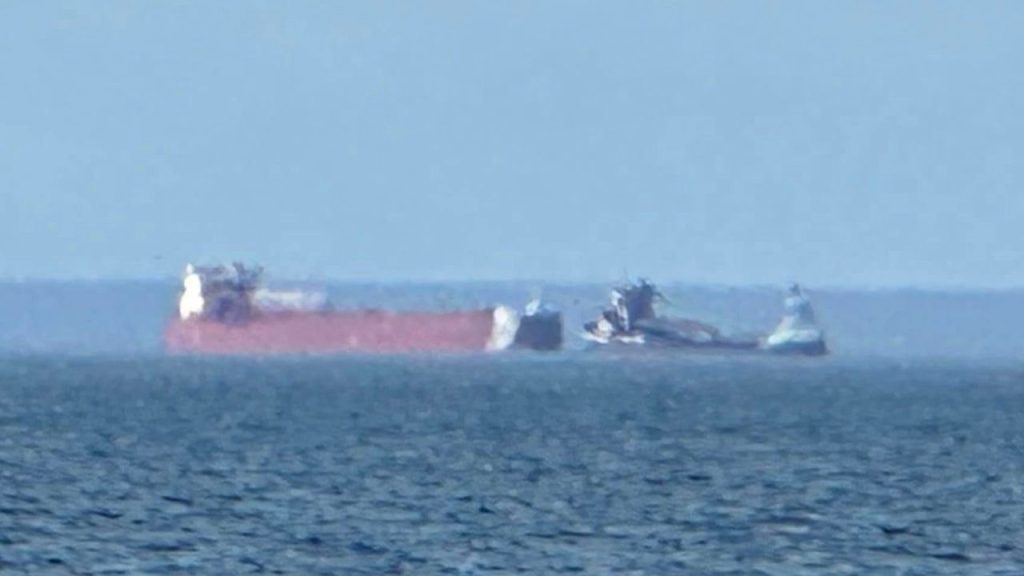A 689-foot freighter named the Michipicoten hit an underwater obstacle in Lake Superior near Grand Portage, Minnesota, causing the ship to take on water. Approximately half of the 22 people on board were forced to evacuate. The ship, carrying taconite, a low-grade iron ore, was located around 35 miles southwest of Isle Royale at the time of the incident. Despite the flooding, the U.S. Coast Guard reported that there was no evidence of any substances spilling into the water. Pumps on board were working to displace the water and reduce the ship’s listing from 15 degrees to 5 degrees. The Michipicoten was en route to port for repairs, with the bulk carrier Edwin H. Gott alongside it.
Authorities, including the U.S. Coast Guard, Border Patrol, and National Park Service vessels, were actively involved in responding to the situation. The cause of the collision that led to the ship taking on water was still under investigation. The Michipicoten was in the northwest part of Lake Superior, which straddles the U.S.-Canadian border and is the largest freshwater lake in the world by surface area. The incident highlights the dangers faced by maritime vessels while navigating through bodies of water and the importance of prompt response and coordination among agencies during emergencies at sea.
The collision of the Michipicoten with an underwater obstacle in Lake Superior occurred near Grand Portage, Minnesota, resulting in the ship taking on water and prompting the evacuation of half of the people on board. The vessel was carrying taconite, a low-grade iron ore, and was located around 35 miles southwest of Isle Royale at the time of the incident. Despite initial concerns about potential spills into the water, authorities confirmed that there was no evidence of such occurrences. Efforts to displace the water and reduce the ship’s listing were ongoing, with the Michipicoten headed to port for necessary repairs alongside the bulk carrier Edwin H. Gott.
Emergency response efforts involving the U.S. Coast Guard, Border Patrol, and National Park Service vessels were actively underway following the collision, with investigations into the cause of the incident ongoing. The northwest part of Lake Superior, where the collision occurred, spans the U.S.-Canadian border and is renowned as the largest freshwater lake in the world by surface area. The incident underscores the risks faced by maritime vessels while navigating through waterways and the vital role of swift and coordinated responses by multiple agencies during maritime emergencies. The collaborative efforts of various authorities were crucial in managing the situation and ensuring the safety of individuals involved in the incident.
The collision involving the Michipicoten in Lake Superior near Grand Portage, Minnesota, highlighted the challenges faced by maritime vessels and the importance of effective emergency response measures. The ship struck an underwater obstacle, leading to it taking on water and necessitating the evacuation of some individuals on board. The freighter was transporting taconite, a low-grade iron ore, and was situated close to Isle Royale when the incident occurred. Despite concerns about potential spills into the water, authorities confirmed that no substances had leaked into the lake. Ongoing efforts focused on using pumps to displace the water and reduce the ship’s listing, with plans for the vessel to undergo repairs upon reaching port alongside another carrier.
The collaborative response efforts involving the U.S. Coast Guard, Border Patrol, and National Park Service vessels were vital in managing the situation and addressing the impacts of the collision. Authorities were actively engaged in investigating the cause of the incident, which occurred in the northwest region of Lake Superior, a vast freshwater lake shared by the U.S. and Canada. The incident highlighted the risks inherent in maritime navigation and the need for comprehensive emergency preparedness to mitigate potential hazards. The coordinated response by various agencies underscored the significance of timely and effective interventions in safeguarding individuals and minimizing environmental impact during maritime emergencies.


